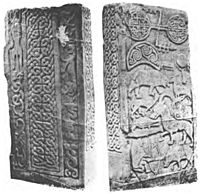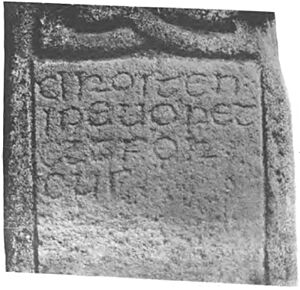Drosten Stone facts for kids
Quick facts for kids The Drosten Stone |
|
|---|---|

The Drosten Stone
|
|
| Writing | Roman script: DROSTEN: IPEUORET [E]TTFOR CUS |
| Symbols |
|
| Created | 9th century CE |
| Present location | St Vigeans, Angus, Scotland |
| Classification | Class II Cross slab (defaced) |
| Culture | Picto-Scottish |
The Drosten Stone is an ancient carved stone from the 9th century. You can find it in St Vigeans, a village near Arbroath in Scotland. It's a special type of stone called a Pictish stone, made by the Picts. Sometimes, experts call it St Vigeans 1.
Contents
What is the Drosten Stone?
The Drosten Stone is a Class 2 cross-slab. This means it's a flat, rectangular stone. One side has a large cross carved into it. The other side shows different symbols. What makes this stone special is its writing, which is not in the usual ogham script found on many Pictish stones.
What Does the Inscription Say?
The writing on the Drosten Stone uses Roman letters, which is unusual for Pictish stones. It reads:
DROSTEN:
IPEUORET
[E]TTFOR
CUS
Who Was Drosten?
Historians have studied the inscription to understand its meaning. One expert, Thomas Owen Clancy, thinks the text is in an old form of Gaelic. He suggests it means "Drosten, in the time of Uoret, and Forcus."
Clancy has a few ideas about who Drosten might have been:
- A Memorial Stone: It could be a monument for a noble person or a church leader named Drosten. Drosten was a common name among the Picts, similar to Tristan. This Drosten might have died during the rule of Uoret and Fergus.
- A Dedication to Saints: The stone might be dedicated to a popular Pictish Saint named Drostan, or perhaps to Saints Drostan and Fergus.
- Made by Drosten and Fergus: Another idea is that Drosten and Fergus themselves had the stone made.
Clancy believes the stone was carved during the time of the Pictish king Uurad (also known as Uoret), who ruled from 839 to 842 AD. It's rare for Pictish stones to be dated so precisely!
Other Ideas About the Name Uoret
Another scholar, Guto Rhys, has a different idea about the word UORET. He thinks it might be a person's name, or it could be an old Pictish word meaning "protection."


